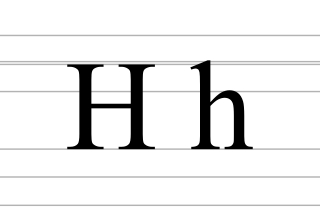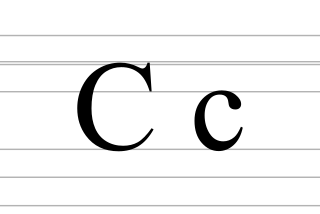
H, or h, is the eighth letter of the Latin alphabet, used in the modern English alphabet, including the alphabets of other western European languages and others worldwide. Its name in English is aitch, or regionally haitch.
Modern Hebrew has 25 to 27 consonants and 5 vowels, depending on the speaker and the analysis.

Y, or y, is the twenty-fifth and penultimate letter of the Latin alphabet, used in the modern English alphabet, the alphabets of other western European languages and others worldwide. According to some authorities, it is the sixth vowel letter of the English alphabet. Its name in English is wye, plural wyes.
Chi is the twenty-second letter of the Greek alphabet.
Finnish orthography is based on the Latin script, and uses an alphabet derived from the Swedish alphabet, officially comprising twenty-nine letters but also including two additional letters found in some loanwords. The Finnish orthography strives to represent all morphemes phonologically and, roughly speaking, the sound value of each letter tends to correspond with its value in the International Phonetic Alphabet (IPA) – although some discrepancies do exist.
A caronKARR-ən. or háček, is a diacritic mark placed over certain letters in the orthography of some languages, to indicate a change of the related letter's pronunciation. Typographers tend to use the term caron, while linguists prefer the Czech word háček.
A phonemic orthography is an orthography in which the graphemes correspond consistently to the language's phonemes, or more generally to the language's diaphonemes. Natural languages rarely have perfectly phonemic orthographies; a high degree of grapheme–phoneme correspondence can be expected in orthographies based on alphabetic writing systems, but they differ in how complete this correspondence is. English orthography, for example, is alphabetic but highly nonphonemic.

The Polish alphabet is the script of the Polish language, the basis for the Polish system of orthography. It is based on the Latin alphabet but includes certain letters (9) with diacritics: the acute accent – kreska: ⟨ć, ń, ó, ś, ź⟩; the overdot – kropka: ⟨ż⟩; the tail or ogonek – ⟨ą, ę⟩; and the stroke – ⟨ł⟩. The letters ⟨q⟩, ⟨v⟩, and ⟨x⟩, which are used only in foreign words, are usually absent from the Polish alphabet. Additionally, before the standardization of Polish spelling, ⟨qu⟩ was sometimes used in place of ⟨kw⟩, and ⟨x⟩ in place of ⟨ks⟩.

A digraph or digram is a pair of characters used in the orthography of a language to write either a single phoneme, or a sequence of phonemes that does not correspond to the normal values of the two characters combined.
Italian orthography uses the Latin alphabet to write the Italian language. This article focuses on the writing of Standard Italian, based historically on the Florentine variety of Tuscan.
The Catalan and Valencian orthographies encompass the spelling and punctuation of standard Catalan and Valencian. There are also several adapted variants to the peculiarities of local dialects of Insular Catalan.
Dutch orthography uses the Latin alphabet. The spelling system is issued by government decree and is compulsory for all government documentation and educational establishments.

Ch is a digraph in the Latin script. It is treated as a letter of its own in the Chamorro, Old Spanish, Czech, Slovak, Igbo, Uzbek, Quechua, Ladino, Guarani, Welsh, Cornish, Breton, Ukrainian Latynka, and Belarusian Łacinka alphabets. Formerly ch was also considered a separate letter for collation purposes in Modern Spanish, Vietnamese, and sometimes in Polish; now the digraph ch in these languages continues to be used, but it is considered as a sequence of letters and sorted as such.
Polish orthography is the system of writing the Polish language. The language is written using the Polish alphabet, which derives from the Latin alphabet, but includes some additional letters with diacritics. The orthography is mostly phonetic, or rather phonemic—the written letters correspond in a consistent manner to the sounds, or rather the phonemes, of spoken Polish. For detailed information about the system of phonemes, see Polish phonology.

J, or j, is the tenth letter of the Latin alphabet, used in the modern English alphabet, the alphabets of other western European languages and others worldwide. Its usual name in English is jay, with a now-uncommon variant jy.

C, or c, is the third letter of the Latin alphabet, used in the modern English alphabet, the alphabets of other western European languages and others worldwide. Its name in English is cee, plural cees.

Portuguese orthography is based on the Latin alphabet and makes use of the acute accent, the circumflex accent, the grave accent, the tilde, and the cedilla to denote stress, vowel height, nasalization, and other sound changes. The diaeresis was abolished by the last Orthography Agreement. Accented letters and digraphs are not counted as separate characters for collation purposes.
In the Latin-based orthographies of many European languages, including English, a distinction between hard and soft ⟨c⟩ occurs in which ⟨c⟩ represents two distinct phonemes. The sound of a hard ⟨c⟩ often precedes the non-front vowels ⟨a⟩, ⟨o⟩ and ⟨u⟩, and is that of the voiceless velar stop,. The sound of a soft ⟨c⟩, typically before ⟨e⟩, ⟨i⟩ and ⟨y⟩, may be a fricative or affricate, depending on the language. In English, the sound of soft ⟨c⟩ is.
This article aims to describe the phonology and phonetics of central Luxembourgish, which is regarded as the emerging standard.














